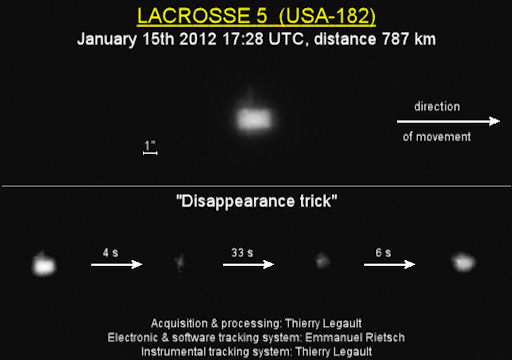QUIET SUN: With no sunspots actively flaring, the sun's output has flatlined again. NOAA forecasters put the chance of an M-class flare during the next 24 hours at no more than 1%. Solar activity should remain low. Solar flare alerts: text, voice.
AURORA WHIRLPOOL: On Feb. 14-15, Arctic skies erupted with an unexpected display of auroras that veteran observers said was among the best in months. At the height of the event, a US Defense Meteorological Program satellite photographed a whirlpool of Northern Lights over the Bering Sea:
"A number of images from the DMSP F18 satellite captured the dramatic auroral event of the last couple nights," says analyst Paul McCrone, who processed the data at the US Navy's Fleet Numerical Meteorology and Oceanography Center in Monterey, CA.
The reason for the outburst is still not completely clear. It started on Feb. 14th when a magnetic disturbance rippled around the north pole. No CME was obvious in local solar wind data at the time; the disturbance just happened. Once begun, the display was amplified by the actions of the interplanetary magnetic field (IMF). The IMF near Earth tipped south, opening a crack in our planet's magnetic defenses. Solar wind poured in and fueled the auroras.
more images: from Göran Strand of Östersund, Sweden; from Heidi Pinkerton of Birch Lake, Babbitt, Minnesota; from Roger Schneider of Tromso, Norway; from Hanneke Luijting of Tromsø, Norway; from Peter Rosén of Abisko NP, Sweden; from Jesper Grønne of Silkeborg Denmark
SPY-SAT DISAPPEARING TRICK: US spy satellite Lacrosse 5 occasionally confounds observers by disapppearing: In a matter of seconds, it can fade more than three astronomical magnitudes. Is this a deliberate form of stealth? Most experts think not, but no one outside of classified circles knows for sure what is going on.
To investigate, French astrophotographer Thierry Legault used his satellite-tracking telescope to photograph Lacrosse 5 as it sailed 490 miles above Paris on Jan. 15, 2012, and he caught the spysat in the act of disappearing:
"During the passage, the brightness of the satellite decreased by 10 times in only 4 seconds (a loss of 2.5 magnitudes)," describes Legault. "After 33 seconds of [dark flight] it regained its original brightness. Lacrosse 5 often shows this very singular behaviour, which is called by other observers (especially Marco Langbroek) the 'disappearing trick.'"
Other Lacrosse satellites do not perform the same trick, at least not to this extent, suggesting that the design of Lacrosse 5 differs from its predecessors. The fade is likely caused by some sort of self-shadowing--e.g., maybe some part of the spacecraft such as its solar panels casts a shadow over the main body when the spysat changes attitude.
Even Legault's fine images do not reveal the answer. "The cause of the disappearing trick, as well as the precise shape of the satellite, remain unknown."
Readers, would you like to try catching the tricks of Lacrosse 5? Check SpaceWeather's Simple Satellite Tracker and Flybys App for local flyby times.
![]()

![]()
Solar wind
speed: 311.8 km/sec
density: 0.1 protons/cm3
explanation | more data
Updated: Today at 1534 UT
![]()
X-ray Solar Flares
6-hr max: B2 1203 UT Feb17
24-hr: B2 1203 UT Feb17
explanation | more data
Updated: Today at: 1500 UT
![]()
![]()
![]()
Daily Sun: 17 Feb 12
![]()
![]()
Solar activity is low. None of these sunspots is actively flaring. Credit: SDO/HMI
![]()
![]()
![]()
Sunspot number: 41
What is the sunspot number?
Updated 16 Feb 2012
Spotless Days
Current Stretch: 0 days
2012 total: 0 days (0%)
2011 total: 2 days (<1%)
2010 total: 51 days (14%)
2009 total: 260 days (71%)
Since 2004: 821 days
Typical Solar Min: 486 days
Updated 16 Feb 2012
The Radio Sun
10.7 cm flux: 103 sfu
explanation | more data
Updated 16 Feb 2012
![]()
![]()
![]()
Current Auroral Oval:
Switch to: Europe, USA, New Zealand, Antarctica
Credit: NOAA/POES
![]()
![]()
![]()
Planetary K-index
Now: Kp= 0 quiet
24-hr max: Kp= 2 quiet
explanation | more data
![]()
Interplanetary Mag. Field
Btotal: 5.2 nT
Bz: 1.9 nT north
explanation | more data
Updated: Today at 1536 UT
![]()
![]()
![]()
Coronal Holes: 17 Feb 12
![]()
![]()
Solar wind flowing from this coronal hole could reach Earth on Feb. 18. However, the solar wind stream is likely to sail south of our planet, making little impact. Credit: SDO/AIA.






